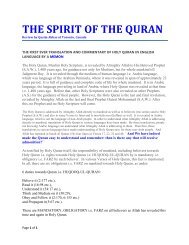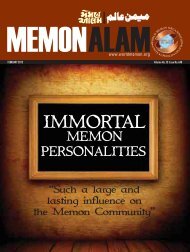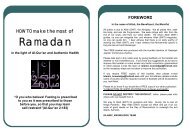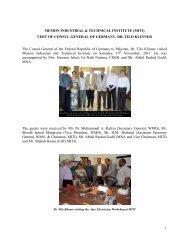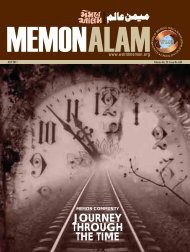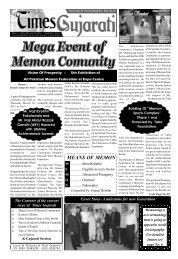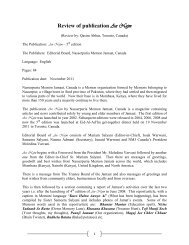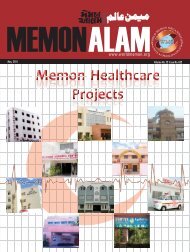August 2011 Final Pages.indd - World Memon Organization ...
August 2011 Final Pages.indd - World Memon Organization ...
August 2011 Final Pages.indd - World Memon Organization ...
You also want an ePaper? Increase the reach of your titles
YUMPU automatically turns print PDFs into web optimized ePapers that Google loves.
MEDICAL SCIENCE<br />
1. Local Steroid Injection<br />
Local steroid injection is a non surgical<br />
treatment for patients who fail to<br />
get relief from medication and physical<br />
therapy, but whose conditions don’t warrant<br />
surgery.<br />
“Many patients are treated successfully<br />
with local steroid injection even more<br />
than the number of patients who require<br />
surgery,” Dr. Verapan notes. “The specific<br />
injection can be curative while at the same<br />
time confirming that the area of injection<br />
is the source of the problem. MRI results<br />
sometimes identify multiple possible areas<br />
of degenerated discs. To pinpoint a precise<br />
injection area, the doctor has to evaluate<br />
many pieces of information such as a patient’s<br />
clinical examination results, medical<br />
records, and the opinions of the surgical<br />
team. This is all taken into consideration<br />
when formulating an effective treatment<br />
plan.”<br />
The anti inflammatory medication lasts<br />
for about three month. For many patients,<br />
the pain disappears, but recurrence is<br />
possible if patients don’t correct their unhealthy<br />
habits such as poor posture or sedentary<br />
lifestyles. “In more serious cases,<br />
spinal injection may help for a while, but<br />
the pain can return once the medication<br />
wears off, “Dr. Verapan explains. “The<br />
patient may eventually require surgical<br />
treatment as a last resort. By this stage,<br />
the doctor would already know the nature<br />
of the problem, so the surgery can be<br />
more precise, with smaller incisions and<br />
faster patient’s recovery.”<br />
2. Endoscopic Spine Surgery<br />
Endoscopic spine surgery is a procedure<br />
that uses a tiny camera to help treat chronic<br />
back pain caused by herniated spinal discs<br />
or lumbar spinal stenosis - degenerative<br />
spinal disorders stemming from repeated<br />
improper use of the spine over an extended<br />
period of time. Dr. Verapan explains the<br />
procedure: “Endoscopic surgical techniques<br />
and tools were invented by a German<br />
doctor. The procedure involves a small<br />
incision requiring surgical skills as much<br />
as advanced equipment. Our surgical team<br />
has been working with German doctors to<br />
improve techniques and procedures as well<br />
as to develop more advanced tools. So we<br />
have now reached the point of becoming<br />
a medical knowledge center for endoscopy<br />
in Asia, with a team of surgeons capable<br />
of performing edoscopic spine surgeries for<br />
more than 95 percent of cases of patients<br />
with herniated spinal discs and lumbar<br />
spinal stenosis.” Endoscopic spine surgery<br />
is typically recommended for patients with<br />
spinal disorders that cause, and are coupled<br />
with, pain and weakness in the legs.<br />
3. Artificial Disc Replacement<br />
Artificial disc replacement (ADR) is a<br />
surgical procedure in which a damaged<br />
or degenerated spinal disc in the neck<br />
or back is replaced with an artificial<br />
disc. Following successful recovery from<br />
surgery, patients can enjoy normal body<br />
movement and resume their daily lives<br />
without pain.<br />
“ADR is a significant improvement over<br />
conventional spinal fusion surgery, which<br />
placed a heavy burden on neighboring joints<br />
that could eventually lead to further disc<br />
degeneration,” notes Dr. Verapan. Disc<br />
replacement surgery as a last resort option<br />
to be considered only when all other treatments<br />
prove unsuccessful.”<br />
While treatments for spinal disorders continue<br />
to improve, the main cause of chronic<br />
back and neck pain - bad posture - remains<br />
unchanged.” After treatment,” urges Dr.<br />
Verapan, “Patients who don’t want their<br />
pain to recur need to be vigilant about doing<br />
strengthening exercises for back muscles<br />
and practicing correct body posture.”<br />
Bone Joints<br />
Consuming a healthy diet is one of<br />
the most important things in safeguarding<br />
health. There is a special<br />
connection between particular foods and the<br />
maintenance of healthy cartilage, joints and<br />
muscles. Certain foods can help strengthen,<br />
as well as prevent the destruction of joints.<br />
The joints are the intersection of two<br />
bones. The ends of the bones are covered<br />
with cartilage (smooth, durable substance<br />
that allows bones to glide over each other<br />
with minimal friction). Cartilage also acts as<br />
a cushioning device to absorb force applied<br />
to the joints.<br />
What is joint pain (Osteoarthritis)?<br />
Osteoarthritis is a degenerative disease of<br />
the joints. In this condition the cartilage<br />
(cushion) present on the bone is destroyed<br />
(mainly due to age factor) and is broken in<br />
pieces.<br />
Who may be affected by this disease?<br />
Most commonly middle aged and older<br />
people are affected. This disease affects fifty<br />
percent of the people by the age of 65. OA<br />
can range from very mild to very severe.<br />
Women are more affected before the age of<br />
40 while men are more affected after 40. It<br />
affects hands and weight-bearing joints such<br />
as knees, hips, feet and the back.<br />
What are symptoms?<br />
Wear and tear on cartilage in the joints<br />
breaks it down, creating crevices and<br />
bumps. This caused stiffness, pain, and loss<br />
of flexibility that gradually worsens. Typical<br />
symptoms include pain in frequently used<br />
joints such as the hands, shoulders, hips,<br />
knees etc. The joints that are affected most<br />
often are those that bear the body weight.<br />
Prevention & Treatment<br />
You can reduce disease progression and<br />
severity of pain by following few guidelines.<br />
Fat or obese people feel more severe<br />
pain. Increased weight makes the pain and<br />
inflammation worse in joints of knee, ankle<br />
and hip. To reduce weight, eat proper diet<br />
and do some exercises. It will help to reduce<br />
the symptoms. Accidents can increase the<br />
risk.<br />
How to live better life with osteoarthritis?<br />
Try to save knees from strains. Sit upright.<br />
If you have to carry weight, try to put it<br />
on healthy and big joints. Try to keep your<br />
body straight. Don’t sit in one position for<br />
a long period, try to walk after a while. Ask<br />
your doctor for advice on our daily activities.<br />
How can you be friendly to your joints?<br />
This disease is progressive and expands<br />
over years and months. With the progress<br />
of medical science, it is possible to limit the<br />
severity of disease, reduce the pain with the<br />
use of drugs.<br />
Pain can also be reduced by physiotherapy.<br />
Do some light exercises. Isometric<br />
exercises are beneficial.<br />
To remain healthy, all cartilage, regardless<br />
of type, needs proteoglycans to attract<br />
and maintain water molecules; however, it<br />
is difficult for most people to achieve a well<br />
balanced diet and therefore dietary supplementation<br />
is often necessary.<br />
Your physiotherapist or physician will<br />
help you in this regard.<br />
MEMON ALAM AUGUST <strong>2011</strong> 33



